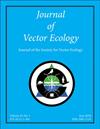在鼠疫流行期间,穴居猫头鹰作为地鼠蚤的潜在传播宿主
IF 1.3
3区 农林科学
Q2 ENTOMOLOGY
引用次数: 0
摘要
摘要:在鼠疫流行过程中,啮齿动物宿主种群的大量灭绝可能导致跳蚤转移到交替宿主或寄生宿主,包括转移到以啮齿动物为食的同域猛禽身上。研究了爱达荷州西南部地松鼠(Urocitellis mollis)鼠疫流行前(2012 - 2014年)、期间(2015 - 2016年)和之后(2017年)洞鸮(Athene cunicularia hypugaea)跳蚤丰度和种类组合。我们检查了(1)是否有更大比例的洞鸮巢穴含有跳蚤,(2)在跳蚤丰度高的类别中猫头鹰的可能性增加,以及(3)在动物流行期间猫头鹰是否窝藏地松鼠跳蚤。通过对236个巢中1184只猫头鹰的跳蚤丰度指数,发现在动物流行的年份,巢的比例和猫头鹰跳蚤丰度高的可能性非但没有增加,反而减少了。此外,在143个猫头鹰巢穴中收集的3538只跳蚤中,没有一种跳蚤是皮特地松鼠通常窝藏的。相反,在所有的研究年收集到的蚤中,刺激蚤是主要的蚤(bbb99 %)。因此,尽管猛禽可能在鼠疫中发挥了作用,但没有证据表明地松鼠的死亡导致了地松鼠跳蚤强度的增加,也没有证据表明它们经常成为可能感染鼠疫耶尔森氏菌的地松鼠跳蚤的偶然或遗传性宿主。本文章由计算机程序翻译,如有差异,请以英文原文为准。
Burrowing owls as potential phoretic hosts of ground squirrel fleas during a plague epizootic
ABSTRACT: During the course of a plague epizootic, decimation of rodent host populations may result in the transfer of fleas to alternate or phoretic hosts, including to sympatric raptors that prey on rodents. We studied flea abundance and flea species assemblages on burrowing owls (Athene cunicularia hypugaea) in southwestern Idaho before (2012 – 2014), during (2015 – 2016), and after (2017) an epizootic of plague in Piute ground squirrels (Urocitellis mollis). We examined (1) if a larger proportion of burrowing owl nests contained fleas, (2) the likelihood that owls within a high flea abundance class increased, and (3) if owls harbored ground squirrel fleas during the epizootic. Using a flea abundance index assigned to 1,184 owls from 236 nests, the proportion of nests and the likelihood that owls had high flea abundance decreased rather than increased during epizootic years. Moreover, of 3,538 collected fleas from owls at 143 nests, no fleas were species that Piute ground squirrels typically harbor. Instead, Pulex irritans was the predominant flea collected in all study years (> 99%). Thus, although raptors may play a role in plague, there was no evidence that the die-off of ground squirrels resulted in higher flea intensity in burrowing owls or that they served as frequent accidental or phoretic hosts for ground squirrel fleas that could potentially be infectious with Yersinia pestis.
求助全文
通过发布文献求助,成功后即可免费获取论文全文。
去求助
来源期刊

Journal of Vector Ecology
生物-昆虫学
CiteScore
2.60
自引率
5.90%
发文量
31
审稿时长
6-12 weeks
期刊介绍:
The Journal of Vector Ecology is an international journal published by the Society for Vector Ecology. It is concerned with all aspects of the biology, ecology, and control of arthropod and vertebrate vectors and the interrelationships between the vectors and the agents of disease that they transmit. The journal publishes original research articles and scientific notes, as well as comprehensive reviews of vector biology based on presentations at Society meetings. All papers are reviewed by at least two qualified scientists who recommend their suitability for publication. Acceptance of manuscripts is based on their scientific merit and is the final decision of the editor, but these decisions may be appealed to the editorial board. The journal began publishing in 1974 and now publishes on-line only.
 求助内容:
求助内容: 应助结果提醒方式:
应助结果提醒方式:


